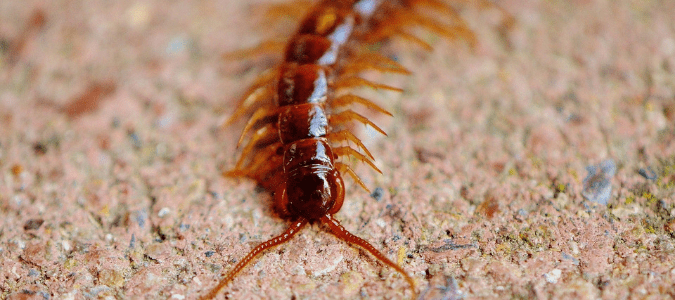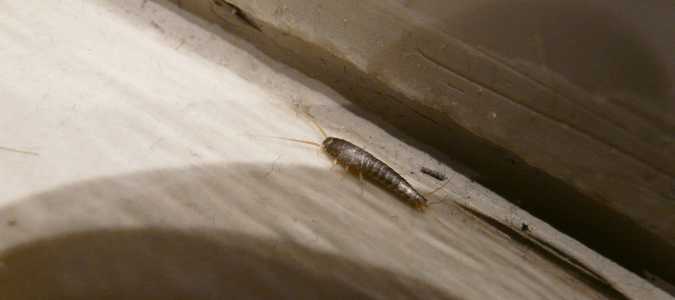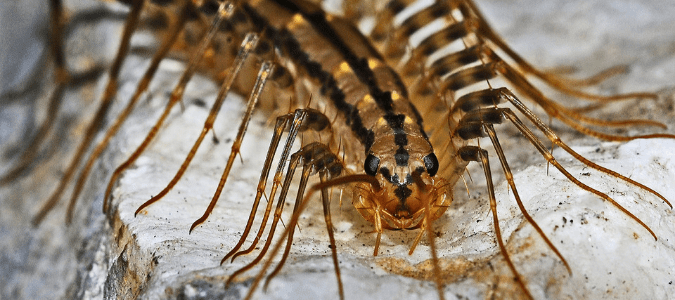
If you had to make a list of the creepiest of creepy-crawlies you’d rather not have in your home, Florida centipedes would probably be near the top. Who wants a pest with all those legs showing up inside?
Centipedes do more than freak Floridians out in the middle of the night. These creatures bite, which can be pretty painful, due to the toxins they release. You won’t get sick from a centipede bite, and they are certainly not fatal, but victims will tell you a close encounter is still quite unpleasant.
To make matters worse, these arthropods lay dozens of eggs at a time, which can easily turn into a horrifying centipede infestation in your home. To add insult to injury, a pest control expert will tell you that when centipedes show up inside your house, it’s likely that other pests are also present.
Why is that?
Centipedes are situated right in the middle of the insect and pest food chain. Centipedes eat insects, including other centipedes, small spiders and worms. Spiders, beetles and other larger pests will prey on young centipedes. Most likely, you don’t want any of these pests making their home in your living spaces, kitchen or bathroom.
As a homeowner in Florida, you’ll want to be able to identify some of the most common centipedes that invade our spaces, as some are more aggressive than others. The most common Florida centipedes are Florida blue centipedes, house centipedes and bark centipedes. Let’s learn a little about each type.
Florida Blue Centipedes
As the common name gives away, these pests are usually bluish-gray in color and grow to be about three inches in length. When bitten, people report feeling a sensation similar to a bee sting. These centipedes are also known by their scientific name: Hemiscolopendra marginata. Florida blue centipedes have pincher-like fangs with poison ducts and a pair of antennae. You do want to watch out for this type of centipede, as they tend to be aggressive if they feel threatened.
House Centipedes
The house centipede, also known as Scutigera coleoptrata, has an abundance of long legs extending out from its body. The body of the house centipede is usually only about an inch in length. However, if you measure their legs, house centipedes are around three to four inches in total length. This pest is black and yellow in color. When frightened, these creatures will run away by lifting their bodies off the ground with their long legs and quickly scurrying away. These centipedes are not aggressive and will always try to hide if they are caught. Likely, they will only bite if you pick one up and start playing with it (which we don’t recommend).
Bark Centipedes
The bark centipede or Scolopocryptops sexspinosus is reddish-brown with yellow legs. Usually growing to an inch or two long, these creatures have a set of legs for each segment of their body. Similar to other types of centipedes, bark centipedes are fast runners. These pests aren’t necessarily aggressive. However, if you pick one up, you may very well get bitten.
Centipede infestations are not the easiest to prevent or control, unfortunately. Centipedes look for any crack or entryway that allow entry to the inside, and they generally come out at night, making it hard for homeowners to discover where they’re living and how they found a way in. It’s especially hard to stop an infestation once centipedes start breeding, as they lay up to 55 eggs at a time.
When can you be sure you have a full-blown infestation? And when you determine you have a problem, what can you do about it?

Centipede Infestations: The Signs And How To Prevent Them
Centipedes are usually more of a nuisance than the destructive pest. That said, many homeowners consider a handful of centipedes found over the course of a few days to be a problem. Like many other household invaders, unfortunately, if you see one centipede, there could be others lurking in out-of-the-way spots.
Inspect Your Home
There aren’t too many signs of a centipede infestation other than spotting the creatures themselves. They don’t do much damage to your belongings, as other pests do, and are satisfied eating insects around the home. Centipedes don’t smell or sound a particular way, either. So, if you have centipedes crawling around your home, your first sign of an infestation will probably be seeing them with your own eyes.
A centipede infestation might explain why your pet has bites, although of course it’s more likely that your dog or cat has been infested with fleas. Keep in mind that centipedes are unlikely to bite humans unless they are scared or feel threatened. In other words, you most likely won’t wake up covered in centipede bites, while you might get mosquito or flea bites after spending time outdoors or bed bug bites if your home is infested.
Centipedes tend to prefer dark, damp places. If you want to determine if you have a centipede problem in your home, check those areas first for signs of activity.
Unfortunately, if you do have a centipede infestation, it’s hard to remove them completely, since not all centipedes like to make themselves known. Even if you think you’ve gotten rid of all the centipedes in your home, you might find these creatures coming back in just a few days. To prevent a centipede infestation, you’ll need to take steps to restrict their entry into your home and make your property a less attractive place for these arthropods to live.
Seal Entryways
When you think about the appearance of these creatures, it should come as no surprise that centipedes can travel through the smallest crevices to come in and out of your home. The small slit under the door or the poorly installed counter can serve as a welcome mat to one of these creatures. The first step to getting rid of centipedes is sealing up all of these entrances with caulk or another form of sealant.
Make sure to check and close every entrance to the home. If that means weatherstripping your door, do it. If that includes sealing or blocking an entrance through your chimney, get it done. Centipedes will use any entry they can find to seek shelter and lay their eggs in a safe place. Taking these steps will help also make your home less vulnerable from visits from other insects, including ants.
Remove Debris
Centipedes love compost and grass clippings, since they are damp. If you keep these materials close to your home, you might be giving centipedes an invitation to head inside. Remove these piles, or at least place them farther away from your home, so these pests are less interested in making their shelter in your crawl space.
Treat Other Pest Problems
Some homeowners don’t mind a centipede or two in the house. After all, centipedes eat other household bugs in Florida, like spiders and bed bugs. Larger centipedes may even prey on small centipedes.
But if you want to remove the predators from your home, it’s best to remove the prey first. Without an abundant supply of spiders, bed bugs or ticks, centipedes will be less inclined to make their home on your property.
When it comes to traps and insecticides, it’s important to note that not all pests respond to the same products. Homeowners need to take different steps to remove spiders or other insects. The majority of the time, calling in a pest control professional who knows about centipedes and other pest behavior is the most effective way to come up with the best solution to your problem.
Sometimes what you think is a centipede is actually another creature entirely. Are you sure you are seeing centipedes and not silverfish?

Centipede Vs. Silverfish: What’s The Difference?
Centipedes and silverfish can look pretty similar to some homeowners at first glance. Just like centipedes, silverfish have many legs. However, they aren’t as long or as prominent as a centipede’s legs, and are usually smaller altogether. Additionally, these insects are usually silver, while centipedes are likely to be darker in color. The most distinctive feature of a silverfish is its two large antennae on the top of its body.
Don’t ignore silverfish if you discover that they are appearing in your home more frequently. Why is that? These creatures are often regarded as more destructive than centipedes.
Silverfish like to snack on:
- Wallpaper
- Dry food and crumbs
- Silk, paper and other materials
Centipedes, on the other hand, like to snack on silverfish.
So, if you see one of these pests in your home, you might just have the other nearby. Take the time to eliminate both pests to keep the creepy crawlies in your home at a minimum.
Many homeowners assume that having a clean house will take them out of the running for the next pest hang out spot, but unfortunately, that’s just not always the case.

What Attracts Centipedes To Your Home?
Centipedes often enter homes for an easy source of shelter. After all, they need somewhere to lay all of those eggs.
These creatures love damp areas, like a bathroom, but nothing too damp. So one reason they might head inside is to escape a rainstorm or its muddy aftermath. They also may wander into your home if they find a food source nearby. For example, spiders that have built webs around your home’s exterior or plants that attract other smaller insects could encourage a centipede to stick around.
Centipedes can survive both outside and inside, and there are a number of places in and around your home that can attract centipedes and serve as shelter, including:
- Grass clippings
- Damp leaf piles
- Compost piles
- Firewood storage
When going through the process of eliminating centipedes from your property, it is helpful to know where they will likely be hiding and what they would like to eat.

How To Get Rid Of Centipedes
See a centipede crawling around? Don’t pick it up by one of its legs. Remember, centipedes have a painful and dangerous bite, and anyone who threatens these creatures risks being the next victim. When you see centipedes, promptly remove them—but not with your hands.
How To Safely Remove A Centipede From Your Home
By using a piece of paper and a cup, you can remove a centipede without killing it. Place the cup over the centipede and slowly slide it so that the paper is sealing the cup. Place the centipede as far away from your home as possible.
Some homeowners vacuum these pests instead. To be on the safe side, remove your vacuum bag or empty the vacuum canister into a bag that you place in the outside trash to make sure these pests don’t make their way back inside.
Of course, getting rid of your centipede infestation by removing them one by one can be a neverending task, especially because these pests like to come out at night. So, there are some other things you can try.
Traps And Insecticides
Glue traps and other traps can help to capture a centipede during the night when they’re more likely to be crawling around. Just be aware that you’ll have to go retrieve whatever centipedes get caught in those traps. If you’re particularly squeamish, this may not be a great option for you.
Applying insecticides around the perimeter of your home can be a way to keep centipedes from entering your home. As with any type of chemicals, use extreme caution and follow all manufacturer directions—especially if you have small children or pets.
Dehumidify The House
Another way to remove centipedes is to make the indoor environment unattractive to these creatures. As we have already mentioned, centipedes prefer damp and wet areas because they dry up without enough moisture. Dehumidifying your house can make your home less vulnerable to various types of pest activity. Homeowners can purchase a dehumidifier or take other steps to reduce the moisture level in their home, including improving ventilation in damp areas and fixing leaks.
Unfortunately, while many of these methods can help put a dent in your centipede infestation, they can’t guarantee that you’ll get rid of them entirely.
ABC Can Eliminate Your Centipede Infestation
Most homeowners have to take multiple steps to remove, control and prevent centipede infestations. However, their DIY efforts aren’t always successful, particularly since these creatures can fit through the smallest entryways, move through the night and breed quickly. The experts at ABC Home & Commercial Services can provide you with long-term solutions to control centipedes and all other types of pests from your home and property. With ABC’s help, you won’t have to worry about your home being a haven for these unwelcome visitors.